英语泛读教程第三版第一册第一单元 LOVE 课件
- 格式:pdf
- 大小:2.11 MB
- 文档页数:8
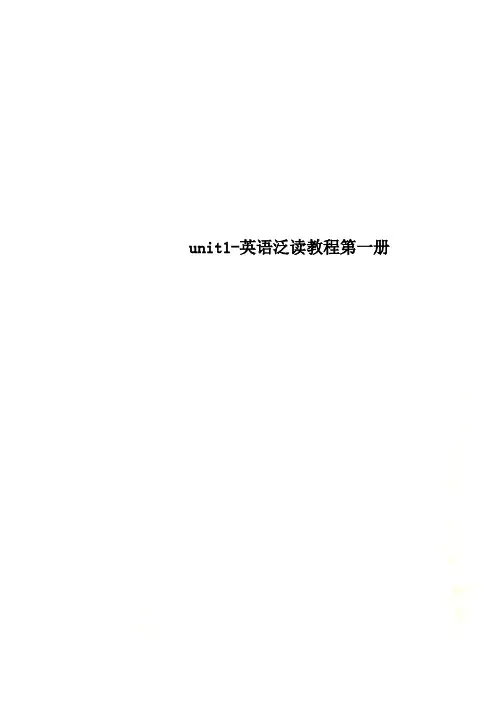
unit1-英语泛读教程第一册课程教案课程名称: 《英语阅读》(一)课程性质: 必修课课程类型: 公共课上课时间: 2017至2018学年第1学期授课对象: 英语教育专业 2017级6班英语翻译专业2017 级3、4班教师姓名: 杨静所属系院: 外国语学院成都师范学院教务处制教案样式(试用稿)使用说明1.教案不等同于讲稿,它应反映教学设计、教学过程和教学内容(讲稿)。
2.一门课程的教案由“课程总体教学安排”、若干的“分次教案”、“课程教学学期总结”三部分组成。
“分次教案”按上课的自然次数划分。
3.每一分次教案由一张“教学设计”页和若干张“授课内容”页两部分组成。
“教学设计”主要包括教学目标、重点与难点、教学方式与手段及各教学引入、讲解、作业等环节的总体安排。
“授课内容”是对各教学环节的详细教学内容、教学方法等的安排及教学提示设计。
为减轻书写负担,已尽量简化了教案首页的项目,有的项目还可根据具体情况酌情简写。
4.全套教案有一封面,供最后装订时使用。
封面上的“课程类型”是指公共课、基础课、专业基础课、专业课等,“课程性质”是指必修、限选、选修等。
5.版面尺寸按A4设计,以便于携带与存档。
6.制作教案时,可使用网上的电子样本或者印刷稿纸。
“讲稿页”上的“讲课内容”可以完全手工书写,也可以打印或粘贴ppt。
若拟使用ppt,可以直接在ppt 环境下“打印内容”按“讲义(每页3幅幻灯片)”打印输出,此时能直接得到省去表头的“讲稿页”,在它的左侧将有3幅幻灯片,右侧则自动生成了书写“备课札记”的横格线。
“备课札记”供填写注释、讲课的提示语等使用。
7.本教案格式是针对我校多数专业类的课堂教学设计的,对于一些特殊类型或有特殊教学方式的课程,可酌情修改或自行规范教案格式。
课程总体教学安排总学时总学分教学时数分配讲课实验平时测验考试机动考核方式学生人数使用教材与版本课程教学目标课程理论内容安排章节内容时间安排课程实验内容安排课程实验的项目名称学时主要参考资料课程教学第 1、2 次教案-教学设计总节次第至节上课时间年月日章节内容Unit 1 university student life教学目的在完成这一单元,学生将能够:1、获得该课程的一个概貌以及课程学习规划2、熟悉大学生生活,对自己的大学生活有一个总体规划。
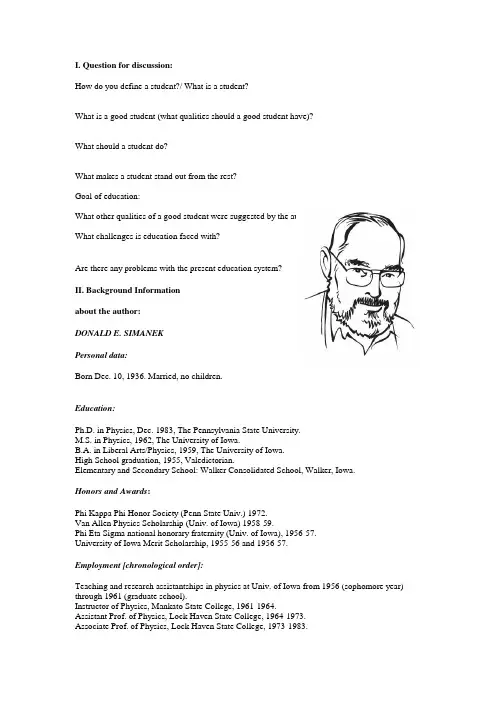
I. Question for discussion:How do you define a student?/ What is a student?What is a good student (what qualities should a good student have)?What should a student do?What makes a student stand out from the rest?Goal of education:What other qualities of a good student were suggested by the author?What challenges is education faced with?Are there any problems with the present education system?II. Background Informationabout the author:DONALD E. SIMANEKPersonal data:Born Dec. 10, 1936. Married, no children.Education:Ph.D. in Physics, Dec. 1983, The Pennsylvania State University.M.S. in Physics, 1962, The University of Iowa.B.A. in Liberal Arts/Physics, 1959, The University of Iowa.High School graduation, 1955, Valedictorian.Elementary and Secondary School: Walker Consolidated School, Walker, Iowa.Honors and Awards:Phi Kappa Phi Honor Society (Penn State Univ.) 1972.Van Allen Physics Scholarship (Univ. of Iowa) 1958-59.Phi Eta Sigma national honorary fraternity (Univ. of Iowa), 1956-57.University of Iowa Merit Scholarship, 1955-56 and 1956-57.Employment [chronological order]:Teaching and research assistantships in physics at Univ. of Iowa from 1956 (sophomore year) through 1961 (graduate school).Instructor of Physics, Mankato State College, 1961-1964.Assistant Prof. of Physics, Lock Haven State College, 1964-1973.Associate Prof. of Physics, Lock Haven State College, 1973-1983.Professor of Physics, Lock Haven University, 1983-1999. (LHSC's name changed to LHU in 1983) Retired, Jan 1, 1999.Research experiences1.1980-82 Condensed Matter research project at the Pennsylvania State University underAnthony Baratta.2.1957. Research expedition doing high altitude studies of cosmic rays using instrumentedrockoons, with James A. Van Allen, near the Arctic Circle.Publications:1.Since 2007 I've done a regular column titled Toys, Tricks and Teasers in MAKE:magazine, and occasional feature articles for them.2.Book reviews in MAKE:, Skeptic and The Skeptical Inquirer3.Editor, The Vector an informal Lock Haven University publication, 1976 to 1991.4.Anisotropy of Conduction Electron Scattering from Vacancies in Copper. Ph.D. Thesis,Department of Physics, The Pennsylvania State University, Dec. 1983.5.Simanek, D. E., Baratta, Lodder and Ehrlich. "Conduction Electron Scattering fromVacancies in Copper. "Physical Review B, 36, 9082 (15 Dec 1987).6.Baratta, A. J., Lodder and Simanek. "Calculation of Conduction Electron Scattering Ratesfrom Vacancies in Copper and Gold." Physical Review B, 36, 9088 (15 Dec 1987).7.Simanek, D. E. "Constructive Fun." The Physics Teacher. (Feb 1994).8.Simanek, D. E. and John C. Holden Science Askew. The institute of Physics Publishing,2002.Since 1997 I have developed and maintained a web site devoted to physics education, science and pseudoscience, skepticism, philosophy of science and other topics. This site has received favorable comment from Physics Today, The Physics Teacher, The New Scientist, Science, The Chronicle of Higher Education, and The London Sunday Times.Areas of special interest:•History and philosophy of science.•The science/pseudoscience boundary.•Photography (Stereo).•Visual illusions.•Meccano/Erector designs for physics demos and labs.•Concept development in physics./%7Edsimanek/vitadon.htmIII. Language points:1. Academic1). [usually before noun] relating to education, especially at college or university levelHe possessed no academic qualifications.a program designed to raise academic standards2). [usually before noun] concerned with studying from books, as opposed to practical workthe study of art as an academic disciplineacademic year [countable]the period of the year during which there are school or university classes2. Accomplishment [transitive]Accomplishto succeed in doing something, especially after trying very hardᅳsynonym achieveWe have accomplished all we set out to do.Mission accomplished (=we have done what we intended to do).accomplishment1). [countable]something successful or impressive that is achieved after a lot of effort and hard workᅳsynonym achievementimpressive/significant/great etc accomplishmentCutting the budget was an impressive accomplishment.It was a major accomplishment for a player who had been injured so recently.2). [uncountable] the act of finishing or achieving something goodaccomplishment ofthe accomplishment of policy goalsThe Apollo program was not so much a scientific achievement as a technical accomplishment. 阿波罗计划与其说是一项科学成果,不如说是一项技术成就。

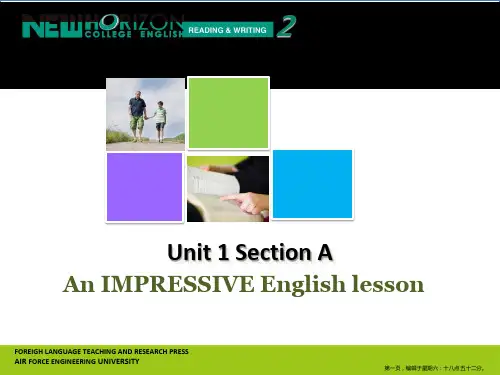
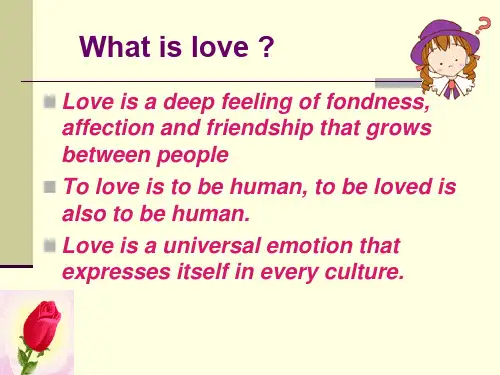

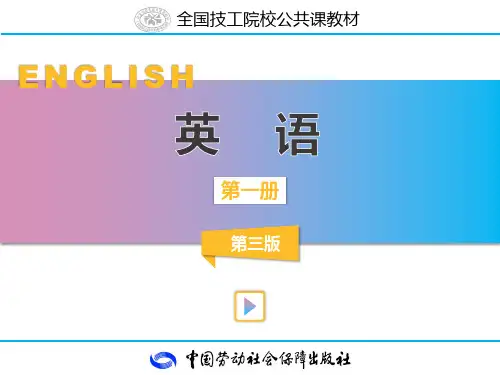
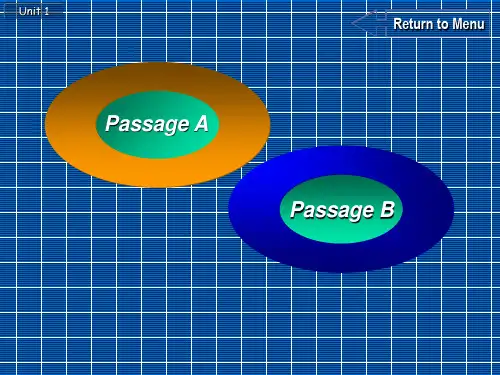



教学日志Unit 1 LoveStep one: Reading skill on Page 7①subheading: a title that divides part of a piece of writing into shorter sections小标题subtitle: a second title which is often longer and explains more than the main title.副标题②preface: an introduction at the beginning of a book, which explains what the book is aboutor why it was written. 序言③index: an alphabetical list that is printed at the back of a book and tells you on whichpages important topics are referred to 索引indices④glossary⑤appendix: extra information that is placed after the end of the main text附录; a smallclosed tube inside your body which is attached to your digestive system阑尾pend=attach depend on⑥bibliography bible⑦supplement: an additional section, written some time after the main text and publishedeither at the end of the book or separately(书籍的)补编,补遗,附录Step two: Background information about Text in Unit 1Some poems that sing high praise for love1. What is love?Love is Mom's kiss and Dad's pat.Love is sweet roses to a lover and tender caresses to a child.Love is the tree of friendship.Love is mutual understanding and support.Love is forgiveness and sacrifice.Love is the never-setting sun in the sky.Love is the spring of the inspiration.Love is a panacea that cures spiritual wounds.Love is the candle in the dark and the fireplace against the cold.Love is a key to open the door of a closed heart.Love is an oasis on a boundless desert which gives a tired walker strength and hope.Love is a harbor in a turbulent sea which makes a weary seaman safe and sound.Love is balmy wind that soothes pain and anxiety from the tempests of the life.Love is the teacher's persistence in giving lectures when he is ill.Love is passing a cup of tea to teachers during the break.Love is sending postcards to parents on their birthdays.Love is a kind of subtle and precious sensation among human beings.Love is all!爱是妈妈的亲吻,爸爸的抚拍。